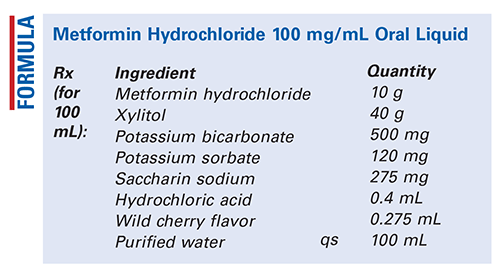US Pharm. 2021;46(11):70-71.

Method of Preparation: Calculate the required quantity of each ingredient for the total amount to be prepared. Accurately weigh or measure each ingredient. Add the potassium bicarbonate and metformin hydrochloride to about 50 mL of purified water, and stir until dissolved. Dilute the hydrochloric acid with about 5 mL of purified water, and slowly add this mixture to the solution while stirring. (This results in carbon dioxide gas formation.) Add the xylitol and potassium sorbate, and stir until dissolved. (It may be necessary to heat to no greater than 30°C.) Cool the solution; then add the flavor and the sodium saccharin, and stir until dissolved. Add sufficient purified water to 99 mL, and mix well. Adjust the pH using a dilute solution of the hydrochloric acid to a pH range of 4.6 to 4.9. Add sufficient purified water to volume, and mix well. Package and label.
Use: Metformin hydrochloride is used in the treatment of diabetes.
Packaging: Package in tight, light-resistant containers.1
Labeling: Keep out of reach of children. Use only as directed.
Stability: A beyond-use date of at least 14 days refrigerated may be used for this preparation.1,2
Quality Control: Quality-control assessment can include weight/volume, pH, specific gravity, active drug assay, color, rheologic properties/pourability, physical observation, physical stability (discoloration, foreign materials, gas formation, mold growth), and preservative-effectiveness test.3,4
Discussion: Metformin hydrochloride (C4H11N5.HCl, MW 165.62) is a biguanide oral hypoglycemic agent. It occurs as a white, crystalline powder that is freely soluble in water and slightly soluble in alcohol.1
Xylitol (C5H12O5, MW 152.15) occurs as white crystals or as a crystalline powder. It has a sweet taste and produces a cooling sensation in the mouth. Xylitol is soluble at about 1 g in 0.65 mL of water, and it is sparingly soluble in alcohol. Crystalline xylitol has a melting range of 92°C to 96°C.1
Potassium bicarbonate (KHCO3, MW 100.12) occurs as colorless, transparent, monoclinic prisms or as a white, granular powder, and it is odorless. Potassium bicarbonate is stable in air, and its solutions are neutral or alkaline to phenolphthalein. It is freely soluble in water and practically insoluble in alcohol.1
Potassium sorbate (C6H7O2K, MW 150.22) occurs as a white, crystalline powder with a faint, characteristic odor. It is used as an antimicrobial (antifungal and antibacterial) preservative, generally in concentrations of approximately 0.1% to 0.2%. Potassium sorbate is soluble in water (1 g in 1.72 mL), acetone (1 g in 1,000 mL), 95% alcohol (1 g in 35 mL), and propylene glycol (1 g in 1.8 mL).5
Saccharin sodium (soluble saccharin, Sucaryl, Sweeta with sorbitol) is a sweetening agent with a molecular weight of 205 for the anhydrous form. It is a white, odorless or faintly aromatic, efflorescent, crystalline powder with an intensely sweet taste and a metallic aftertaste. One gram of saccharin sodium is soluble in about 1.2 mL of water, 50 mL of 95% ethanol, and 3.5 mL of propylene glycol.6
Hydrochloric acid (HCl, MW 36.46) occurs as a clear, colorless, fuming, aqueous solution of hydrogen chloride with a pungent odor. Concentrated hydrochloric acid is 36.5% to 38.0% w/w concentration. It has a specific gravity of 1.18 g/cm3, and it is miscible with water and soluble in ethanol.7
REFERENCES
1. U.S. Pharmacopeia-National Formulary [current revision]. Rockville, MD: U.S. Pharmacopeial Convention, Inc; October 2021.
2. Niazi SK. Handbook of Pharmaceutical Manufacturing Formulations, Volume 3—Liquid Products. Boca Raton, FL: CRC Press; 2004:149.
3. Allen LV Jr. Summary of quality-control testing for sterile and nonsterile compounded preparations, part 1: physical and chemical testing. IJPC. 2019;23(3):211-216.
4. Allen LV Jr. Summary of quality-control testing for sterile and nonsterile compounded preparations, part 2: microbiological testing. IJPC. 2019;23(4):299-303.
5. Quinn ME. Potassium sorbate. In: Sheskey PJ, Hancock BC, Moss GP, Goldfarb DJ, eds. Handbook of Pharmaceutical Excipients. 9th ed. London, England: Pharmaceutical Press; 2020:850-852.
6. Oga E. Saccharin sodium. In: Sheskey PJ, Hancock BC, Moss GP, Goldfarb DJ, eds. Handbook of Pharmaceutical Excipients. 9th ed. London, England: Pharmaceutical Press; 2020:898-901.
7. Mishra M. Hydrochloric acid. In: Sheskey PJ, Hancock BC, Moss GP, Goldfarb DJ, eds. Handbook of Pharmaceutical Excipients. 9th ed. London, England: Pharmaceutical Press; 2020:500-501.
The content contained in this article is for informational purposes only. The content is not intended to be a substitute for professional advice. Reliance on any information provided in this article is solely at your own risk.
To comment on this article, contact rdavidson@uspharmacist.com.





